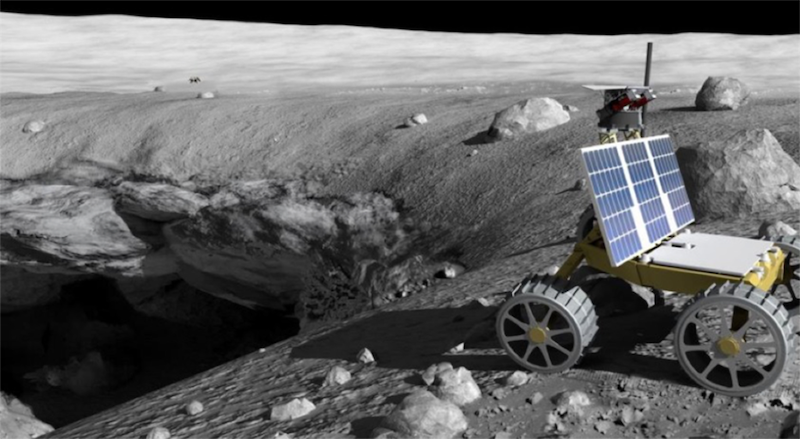

Artist’s concept of a PitRanger surveying a lunar pit. Image via William Whittaker/ USRA/ Carnegie Mellon University.
Curious about what kind of pristine and peculiar science environments lie below the surface of the moon? Meet PitRanger, a tiny rover currently being designed to explore deep pits below the moon’s surface.
PitRanger is currently on track to become the key instrument in a short-term moon mission aimed at capturing high-definition 3D images of moon pits, deep, steep-walled holes thought to have been shaped billions of years ago by a once geologically active moon. Funded by the NASA Innovative Advanced Concepts Program (NIAC), the mini-robot will weigh 33 pounds (15 kg) and be solar-powered, a technological decision that poses many challenges alongside its advantages.
Although no launch dates have been proposed yet, the prototype, built by robotics research scientist William “Red” Whittaker and his team at Carnegie Mellon University, has already undergone and passed testing by performing at a sinkhole here on Earth, and is envisioned for launch in either 2021 or 2022.
Whittaker provided an update on his work during a virtual NIAC meeting held in September 2020, noting that significant progress has been made in the development of the lunar mini-rover.
PitRanger, whenever launched, will be a brief mission compared to the moon rovers before it for reasons that concern the daylight. A lunar day lasts about 14 Earth days, and because solar-powered PitRanger depends on the sun for energy, the equally long lunar night becomes an opportunity for impending robot death. Whittaker emphasized this by saying:
It only has 12 days, not 12 years, to complete its mission.
PitRanger is also different from previous moon exploration missions because of its autonomy. PitRanger is designed with the strategic decision-making and imaging capabilities required to navigate risky ledges around a pit. Autonomy for quick missions like this one is becoming a necessary technology, since supervision and guidance from controllers on the ground won’t be available to such small, solar-powered rovers.
The small lunar rover will operate at a top speed of 1 inch (2.5 cm) per second, and be outfitted with a telephoto lens and panoramic unit in conjunction with a single solar panel. These features will work together using a panel-tilt mechanism to aim its camera at the pit, taking images at various angles that reach the pit’s far wall and floor. PitRanger will be accompanied by a lander, and be programmed with the software smarts to prune and process images later transferred to the lander for modeling. The little robot will do this repeatedly, wheeling back to the pit multiple times to acquire thousands of images and measurements. Once that work is done, the end result will produce a photogrammetric model of the captured pit, providing an up-close and detailed look at what’s inside as well as its shape, size, and other relevant features that provide insight into how the moon behaves — quality that spacecraft cameras in moon-orbit are unable to match. Whittaker said:
The scenario is to rove to a pit with a micro-rover, peer into the pit, acquire images of walls, floors, caverns, and then generate pit models… Pit walls offer the only observable pristine geology on the moon. They are unique opportunities to observe volcanology, morphology and much more.

PitRanger may need to make multiple maneuvers to profile a lunar pit, as this illustration depicts. Image via USRA/ Carnegie Mellon.
It’s still unclear whether PitRanger will visit a single moon pit or if there will be multiple pits on its agenda, however the likely scenario is the latter; there is also no discussion circulating on which pits are currently being targeted. The moon’s surface is battered by these holes, with more than 200 documented by NASA’s Lunar Reconnaissance Orbiter spacecraft, ranging in size from roughly 15 feet (5 m) across to more than half a mile (1 km) in diameter. NASA says that most pits were found either in large craters with impact melt ponds — areas of lava that formed from the heat of the impact and later solidified, or in the lunar maria — dark areas on the moon that are extensive solidified lava flows hundreds of miles across. Exploring these pits would reveal valuable details about the voids in which they formed.
Moon pits, caves, and lava tubes — formed by flowing magma and covered in tiny crystals — are like windows to the moon’s history both within and below its surface. New technology intended for subsurface lunar exploration has been inspired by engineers in recent years, especially since NASA’s plans to return humans to the moon are just on the horizon. Whittaker believes that if accessible, these geologic features could be havens from radiation, extreme temperatures, dust storms, and micrometeorite hazards of the moon’s surface. With this considered, peering into moon pits may not only prove monumental in understanding our natural satellite’s history, but also create safe habitats on the lunar surface as well as a jumping-off point to Mars.

These images from NASA’s LRO spacecraft show all of the known mare pits and highland pits. Each image is 728 feet (200 m) wide. Image via NASA/ GSFC/ Arizona State.
Bottom line: Researchers are building a prototype of a 33-pound (15 kg) lunar mini-robot – called PitRanger – set to be the key instrument in a future mission aimed at capturing high-definition images of moon pits.
Source: Micro-rover exploration of lunar pits deployable by commercial lander
Source:
https://earthsky.org/space/meet-pitranger-a-tiny-rover-to-probe-lunar-underworld